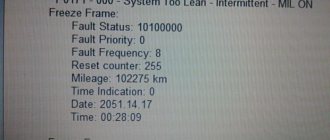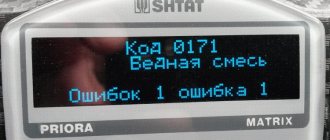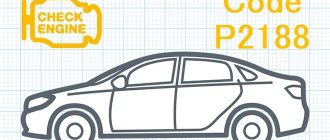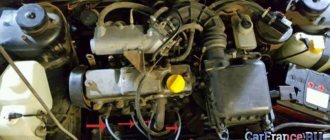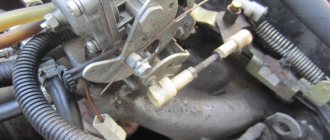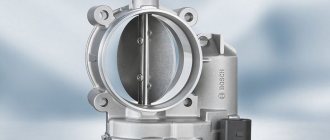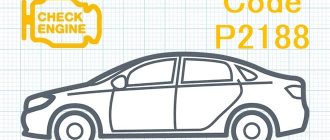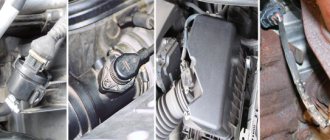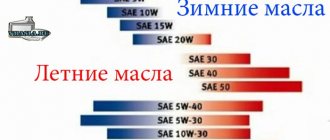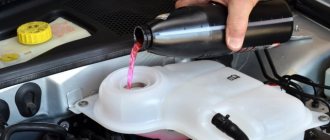A too lean air-fuel mixture is a fairly common problem that leads to serious engine malfunctions. Errors and disturbances in the mixture formation process can occur on carburetor or injection engines, as well as on power units with additionally installed gas equipment.
We also recommend reading the article about the advantages and disadvantages of HBO. From this article you will learn about the effect of gas on the engine, the cost-effectiveness of this solution, the interaction of gas-cylinder equipment with standard power systems, etc.
A lean and rich fuel mixture is a deviation from the norm, as a result of which the engine may begin to overuse fuel, has difficulty starting, loses power in different modes, smokes, and overheats.
For example, if a lean mixture is constantly supplied to the cylinders, the consequences can be quite serious. In a number of cases, the appearance of a white coating on the spark plugs and misfires have been noted; a lean mixture causes local overheating, burnout of valves and melting of the pistons.
In this article we will look at what a lean carburetor is and how to fix a lean mixture. We will also answer the question of what a lean mixture on an injector is, the reasons for a lean mixture when the engine is running on gas, as well as how to detect the problem yourself and carry out repairs.
Signs and causes of lean mixture formation
However, it is very easy to diagnose:
- The simplest and most obvious is that the car stalls when moving. And not only when driving uphill, when this can be attributed to an incorrectly selected gear, but when driving on straight, level roads. However, this is only when the mixture is really lean.
- Another situation is when the car jerks while driving. Especially if you are driving not a fully loaded car, but an empty one, on a flat road. Although in this situation it cannot be said unequivocally that a poor air-fuel mixture is an indispensable reason. You may need to check other vehicle systems, such as the exhaust system.
- Another sign is that the car “shoots” when driving. Although more and more often in new cars this is not due to a lean mixture, but to problems in the exhaust system, this symptom is obvious. Especially when unstable exhaust appears not just once in a while, but constantly, since with single pops the situation is the opposite: the mixture is too rich, and the remaining gasoline that is not burned in the engine burns out in the muffler, ignited by a hot pipe.
- The color of the carbon deposits on the spark plugs can also tell a lot about the composition of the mixture. If he:
- brown, then everything is fine, there is an optimal amount of air-gasoline in the mixture;
- white, or alternatively light, then there is a lot of air in the mixture and it is poor;
- black candles - excess gasoline that does not burn completely;
If signs of a lean mixture are detected, this diagnosis can be confirmed in several ways:
- If the car is equipped with an on-board computer, the “Check Engine” indicator will light up on the dashboard, and P0171 will appear in the error list.
- By contacting a specialized service station, you can test the operation of the engine using a gas analyzer sensor, which is installed in the exhaust pipe.
- Finally, you can use a simple wired or Bluetooth OBD scanner, which costs only a few dollars on Aliexpress, a smartphone and the appropriate software.
You need to look for the cause of the formation of a lean mixture based on the diagnostic results and errors that appear along with P0171. The standard reasons are:
- Problems with sensors (mass air flow sensor, air pressure sensor, diaphragm pressure sensor, oxygen sensor). Incorrect sensor information usually results in an incorrect fuel/air mixture.
- Problems with the EGR valve. The valve may allow more exhaust gases into the engine than necessary.
- Timing problems. Incorrectly aligned marks or problems with tensioners can also lead to this problem.
- Problems with the fuel supply (faulty fuel pump, clogged fuel filter or injectors).
- Excess air supply through a crack in the hose or a loose connection in the air supply system.
Dips when pressing the gas - we diagnose and fix the problem
Cars are complex mechanisms with very interesting operating systems. Every time a certain malfunction or problem is detected, the car owner strives to understand its nature, and, if possible, eliminate it himself. If your car begins to experience dips when you press the gas, you should contact a specialist, but before that you can check several of the most common options for the presence of this unpleasant manifestation.
The reasons for this phenomenon may lie in various factors. For carburetor cars, for example, this may even be a physical malfunction and sudden movement of the throttle valve. But often we are talking about the breakdown of certain functions of the electronic control of the fuel supply system. Let's take a closer look at all the intricacies of this breakdown.
Type of failures when pressing the gas - determine the cause of the malfunction
Before drawing any conclusions about the problem, it is worth determining the type of failure, which will often tell you the node in which you need to look for a breakdown. The most common option for carburetor engines is a second lack of traction, and then a sharp jerk. The carburetor itself is often to blame for this, but spark plugs can also be to blame for this phenomenon.
Considering the fairly simple work with candles and wires, this theory is worth checking first. Such failures due to the fault of spark plugs or wires can happen on injection and even diesel power units. The following components may also be responsible for the presence of such problems in a car:
The last breakdown is the most common manifestation that determines the negative aspects of transport operation. Today, a breakdown or failure of the on-board computer to function correctly makes the vehicle impossible to operate. This is the main disadvantage of high technologies that are so eager to be introduced into modern technology.
But failures when pressing the accelerator pedal are not always the result of a failure of the computer or sensors. The most common cause of the problem is broken spark plugs. But if, after replacing the spark plugs, the problem repeats after several hundred kilometers, you should look for the problem in the sensors that affect the enrichment of the mixture. Due to their incorrect operation, spark plugs quickly fail.
Non-standard cases and reasons for failures when pressing the gas pedal
Often, with this problem, drivers turn to specialized service centers, because communication with the specialists of such companies can often tell you non-standard reasons for failures in engine operation. Sometimes, when diagnosing a car, specialists find uneven engine operation, which, combined with failures during acceleration, means a breakdown of the main idle speed and fuel economy sensors.
Sometimes failures occur due to a lack of fuel, but it often happens that gasoline flows like a river without any obstacles, which also prevents it from igniting properly. In such situations, the car may stall and show incredible fuel consumption figures. The only way to deal with such problems is as follows:
A huge range of problems can cause such problems. Therefore, you should not concentrate only on the fuel supply system or only on the spark plugs. It is necessary to comprehensively diagnose the car, find all possible problems and eliminate them. Of course, you can do this yourself only if you have a sufficient number of skills and tools.
By turning to specialists, you get access to the extensive experience of professionals. If you are faced with a certain problem, then other owners of cars of your make and model have also faced this problem more than once. Therefore, with the help of the experience of an official service center, solving the problem will be much easier.
See more information about possible causes of engine failure in the video:
Let's sum it up
If you are faced with a problem such as dips when pressing the gas pedal, go to a car store and buy new spark plugs. This often helps get rid of the problem or temporarily delay a trip to the service center. If the problem recurs again, you should go to specialists and conduct a full diagnosis of the computer control and fuel supply system.
After such a study, you can easily obtain the necessary information about the problem and make a decision to repair or replace certain machine components. Often, repairing such a problem is not too expensive. Have you ever had problems with symptoms such as engine failure?
Source
Fuel to air ratio for fuel mixture
The most optimal ratio of fuel and air for the fuel mixture is 1:14.7. If you change this ratio, the resulting fuel mixture will be:
- power, during the creation of which the amount of air decreased from 15 to 12.5-13. This mixture, enriched with fuels and lubricants, exerts increased pressure on the engine pistons, thereby helping the power unit produce maximum power. The only drawback of this ratio of fuel composition components is an increase in fuel consumption by approximately 20%;
- economical, or lean, consisting of 1 part fuels and lubricants and 16 parts air. In this case, you can achieve a significant reduction in vehicle fuel consumption. But the result of this efficiency is a decrease in the car’s power performance, which is not very suitable for those who like to drive fast. If the lean mixture consists of 1 part fuel and 20 parts air or more, then ignition from a spark will become almost impossible;
- enriched, which contains fuel and air in a ratio of 1:11 or 1:12. If this composition continues to be enriched, this may lead to unpleasant consequences. Due to the fact that such a composition practically loses its ability to ignite, the power unit will not be able to perform its functions and will not be able to start.
Lean and rich fuel assemblies, components and dosing systems
The empirical formula defines a “normal” fuel assembly as a mixture of 14.7 kilograms of atmospheric air and 1 kilogram of liquid fuel. A fuel mixture in which the amount of air is greater than that specified in the ratio is called lean, and, accordingly, rich, with less air.
- poor - air > 14.7
- rich - air » alt=»»>
Uniformity can be achieved by injecting a small amount of an enriched mixture into the ignition zone as a catalyst for the oxidation reaction. In carburetor engines, an additional intake valve is used to solve this problem, and injection systems are equipped with a dual-mode nozzle.
Possible consequences of a lean mixture
Running a car engine for a long time on a lean mixture can cause:
- Burnout of the valve cover/valves themselves. At idle, the engine stalls, and the driver is forced to constantly maintain higher speeds. The effect of this is predictable: repairs that will cost a pretty penny.
- Excessive load on the cooling system. Due to a lean mixture, the engine temperature will always be higher than normal, so the wear of the cooling system elements will be premature.
- Increased fuel consumption. Especially if you are used to driving as hard as you can, then when driving you will have to constantly shift one or two gears down, which will definitely affect your frequent visits to the gas station.
Therefore, if you find that your car is running on a lean air-fuel mixture, then do not delay the repair, but go to the service as quickly as possible. Moreover, the repair can be quite cheap; for example, it is often possible to get by with simply cleaning the throttle valve.
Mixture formation in diesel engines
The mixture formation process is mainly determined by the interaction of the injected fuel jet with the air flow field in the combustion chamber.
The problem here is the rapid injection and preparation of relatively large masses of fuel, up to 200 mg per liter of displacement. Typical injection duration is about 1 ms. The term used to refer to the mass flow rate of fuel entering the combustion chamber is injection rate (unit: kg/s). Fuel injection is usually carried out using multi-hole injectors. Typically a combination of holes with a diameter of 120 to 150 µm is used. Fast fuel injection and mixture formation are facilitated by the small diameter of the holes and high injection pressure, reaching 2000 bar.
Initially, the diameter of the fuel jet is equal to the diameter of the hole. However, after traveling a few millimeters, the jet breaks up into individual droplets that interact with the flow field. The liquid phase of the fuel jet, depending on the density of the working medium, can penetrate several centimeters into the combustion chamber before it is completely atomized or evaporates (see Fig. “Propagation of the fuel jet and mixture formation in diesel engines”).
Turbulence promotes the formation of fuel droplets and evaporation. In modern diesel engines, more than 80% of the turbulence in the fuel jet region is generated by fuel injection. The development of turbulence is facilitated by the movement of the fuel charge, and on diesel engines with a flat cylinder head, horizontal turbulence predominates. Additional contributions may come from compression-induced air flows directed from the outer to the inner region of the combustion chamber (“compression flows”) or from a combustion chamber design that, for example, contacts the hot region of a recess in the piston to promote evaporation.
Over the past few decades, direct fuel injection systems have demonstrated their advantages over indirect injection systems such as swirl chamber or prechamber systems. In systems with indirect fuel injection, fuel preparation is mainly carried out through the formation of a local flow in the pre-chamber.
Ratio - fuel - Great Encyclopedia of Oil and Gas, article, page 1
Ratio - fuel
The fuel to air ratio (F/A) is the reciprocal.
The fuel/oxygen ratio required to obtain maximum power is quite different from that required for maximum economy. It is advisable to identify the reasons for this difference and manage it as necessary.
The ratio of fuel and air is determined by eye by the length of the torch in the firebox and the color of the smoke in the chimney. If there is an automatic gas analyzer, then the amount of air is checked by the CO content behind the boiler. With proper air supply, the color of the flame should be light straw, and the smoke from the chimney should be slightly gray. As the slag cushion builds up on the grate, the opening of the dampers on the air ducts under the grate is gradually increased. Air must be supplied continuously under the grate.
Selecting the ratio of fuel and raw materials is not difficult if the composition of carbonate raw materials is constant.
The influence of the fuel-to-air ratio on the emissivity of the flame is also great. From Fig. 44 it can be seen that with an excess of natural gas, the emissivity is significantly greater than with an excess of air; It is also clear that the luminosity of the flame decreases rapidly if excess air is formed. In addition, the figure shows what the relationship is between the components of flame radiation: gas radiation and solid particle radiation.
Regulation of the fuel to air ratio must be automatic; The pilot should not fiddle with the throttles or check their position.
When the fuel to air ratio is less than 1:13, the combustion rate decreases, engine efficiency and power decrease. A mixture of this composition is called rich. If the ratio of fuel and air in the mixture is more than 1:18, its combustion rate is also sharply reduced, which also leads to a loss of efficiency and power. A mixture of this composition is called lean. When the air content in the mixture is less than 6 kg per 1 kg of fuel or more than 20 kg per 1 kg of fuel, the combustible mixture in the cylinders does not ignite.
It is difficult to regulate air flow and the fuel-to-air ratio to maintain combustion due to the relatively low pressures and high velocities in the combustion chamber. The issue of external motor resistance must be carefully considered in the same way as the issue of specific impulse. The specific impulse is usually less than 100 sec and reaches a maximum at the specific flight speed. The range of specific fuel consumption for the best operating conditions is 0 9 - 1 4 kg-hour per 1 g of thrust.
The composition of the working mixture depends on the ratio of fuel and air. Theoretically, 15 kg of air is needed for complete combustion of 1 kg of fuel. This mixture is called normal.
The analysis performed shows that the introduction of a fuel-to-air ratio regulator, while solving the problem of limiting the temperature rise and maintaining it at a maximum level, at the same time introduces elements of instability and increased overshoot. Therefore, the installation of such a regulator requires a very careful study of the dynamics of regulation and the selection of such dynamic constants and corrective devices, which will weaken the harmful influence of the second regulator on the regulation process.
The steam temperature behind the boiler is controlled by changing the ratio of fuel and water for each housing. Injection desuperheaters are installed in front of the screen superheater and the outlet stage of the convective package.
NO concentration increases to a maximum at that fuel to air ratio that produces the minimum amount of unburned hydrocarbons and carbon monoxide. A further increase in this ratio leads to a decrease in NO concentration, but increases the HC concentration. Thus, we can conclude that by changing only the air-fuel ratio it is impossible to achieve a simultaneous reduction in the amounts of HC, iNO and CO in the exhaust. Many other factors besides those already mentioned affect the emissions of a given spark ignition engine. Detailed discussion of these factors is contained in other sources, as well as in publications of the Society of Automotive Engineers.
Pages: 1 2 3 4 5
www.ngpedia.ru
Recommendations
- Hillier, V. A. W.; Pittak, F.V. (1966). "Subsection 3.2". Basics of Automotive Technology
. London: Hutchinson Educational. ISBN 0 09 110711 3 . - See Example 15.3 in Engel, Yunus A.; Boles, Michael A. (2006). Thermodynamics: an engineering approach
(5th ed.). Boston: McGraw-Hill. ISBN 9780072884951. - Kumfer, B.; Skeen, S.; Axelbaum, R. (2008). "Limits of soot formation in laminar diffusion flames as applied to oxy-fuel combustion" (PDF). Combustion and flame
.
154
: 546–556. doi:10.1016/j.combustflame.2008.03.008. - Introduction to fuels and energy: 1) MOLYTS, MASS, CONCENTRATION AND DEFINITIONS
, date of access 05/25/2011. - "Energy Tips - Process Heating - Checking Burner Air to Fuel Ratios" (PDF). U.S. Department of Energy, Office of Energy Efficiency and Renewable Energy. November 2007. Retrieved July 29, 2013.
- "Stoichiometric combustion and excess air". Engineering ToolBox. Retrieved July 29, 2013.
- Eckerlin, Herbert M. "The Importance of Excess Air in the Combustion Process" (PDF). Mechanical and Aerospace Engineering 406 - Energy Conservation in Industry
. North Carolina State University. Archived from the original (PDF) on March 27, 2014. Retrieved July 29, 2013.
What happens to an engine with an enriched fuel assembly?
The mixture or fuel assembly should not be too rich or lean. Both mixing options can only lead to problems. The distribution of air and gasoline must be carried out strictly according to the instructions, otherwise high fuel consumption, loss of power and other malfunctions cannot be avoided.
Mixture quality chart
Read more about what happens to an engine if you feed it with an enriched fuel assembly.
- Thick black or gray smoke will pour out of the chimney, which will indicate that the fuel has not had time to burn completely.
- The engine will oscillate, and this indicates detonation moments inside it.
- Black soot will settle on the candles.
- Gasoline consumption will increase significantly.
- Slag will accumulate on the walls of engine elements, which will sooner or later lead to a major overhaul.
- The exhaust system will also not be left aside. The constant release of incompletely spent fuel into the pipe, its explosion, will ultimately lead to burnout of the muffler.
In a word, enriching the mixture does not lead to anything good. If measures are not taken in time, you will have to fork out money for engine repairs.
Therefore, it is so important to determine the presence of a rich mixture in time. For example, this is immediately noticeable by an increase in consumption and black candles
Article on the topic: Why engine cooling is needed and how it works
What causes the formation of rich fuel assemblies in the carb? The reasons are different, but the most important of them are: a dirty air filter and clogged jets. Therefore, before you start directly adjusting the carburetor, you need to check these parts. The air filter can be replaced and the jets can be purged.
It happens that the mixture is enriched due to a change in settings. In this case, you have to climb inside the carb.
Reasons for the formation of a rich or lean mixture
Most often, a rich mixture is formed not because more fuel is supplied than necessary, but because less air is supplied than necessary. The most common and common reason is a clogged air filter. Unfortunately, many motorists forget that some components need to be changed regularly, even if they look like new. The air filter is one of these components; it needs to be changed at least every 30 thousand kilometers, and on powerful cars - even more often.
Also, the air supply can be “cut off” by a malfunctioning air pressure sensor - it needs to be adjusted. Paired with it is a fuel pressure sensor, which can also supply underestimated data to the engine's electronic control unit. Based on them, the block begins to pump more fuel into the cylinders, enriching the mixture. As we learned above, it worsens power and dynamics, the control unit doesn’t like it, and it supplies even more gasoline. Hence the greatly increasing fuel consumption.
The reason for the rich fuel mixture may also be hidden in the electronic engine control unit itself. These could be errors in his program, but also incorrect changes made to it. Self-taught craftsmen and simply unskilled craftsmen “tune” the control unit, deliberately increasing the proportion of fuel in the mixture. This way you can achieve a small increase in power, but it is much easier to upset the balance and achieve the opposite result.
The fuel pump can also disrupt the proportions of gasoline and air, pumping much more fuel into the system than necessary. And the most difficult reason to determine is malfunction of the injectors in the cylinders. They can become clogged or deformed, and then the balance of the air-fuel mixture can fluctuate in any direction.
Detonation and spontaneous combustion
Under normal conditions, combustion of the working mixture in the engine cylinders occurs at a speed of 25-30 m/sec and the pressure in the cylinder increases smoothly. The engine operates in normal thermal conditions, without knocking or failure.
When using lower quality fuel, overheating the engine, or setting a very early ignition point, the mixture begins to burn at a speed reaching up to 2000 m/sec. This explosive combustion of the mixture is called detonation. During detonation combustion, the pressure in individual parts of the cylinder increases sharply, metallic knocks appear, engine power drops, and black smoke appears from the muffler. The most harmful phenomenon of detonation affects the condition of the parts of the crank mechanism, where destruction of individual parts is possible.
The tendency of a fuel to detonate is conventionally assessed by its octane number. The higher the octane number, the less prone the fuel is to detonation. Gasoline with a higher octane number is used for engines with a higher compression ratio.
Detonation combustion of a mixture is sometimes mistakenly confused with self-ignition or glow ignition. Self-ignition can occur in the cylinders of an overheated engine at a time when the electric spark has not yet entered the cylinder, as well as during ignition from hot carbon particles or spark plug electrodes. In both cases, the mixture burns at normal speed. This phenomenon is usually observed when the ignition is turned off, while the engine continues to run for some time.
Automatic diagnostic system
If your vehicle's diagnostic system indicates that a "Compound Too Rich" error has occurred, certain actions must be taken. To do this, you need to understand the principles of the scanner.
Air is supplied to the fuel when diagnosing the MAP sensor and lambda probe. Maybe error P0172 is caused by deviations of these particular systems. However, in addition to them, problems may be associated with deviations in thermal clearances (engine with LPG), mechanical damage to sealing materials, insufficient compression or deviation during timing operation.
To understand why automatic diagnostics indicate such an error, the car owner can take several steps. First of all, you need to analyze the information that the scanner provides. Next, you can artificially simulate the conditions for the occurrence of such a malfunction.
The next step could be to check components and mechanisms, such as contacts, absence of suction, as well as the operability of systems related to the supply of fuel and oxygen to the combustion chamber.
Leaning of the fuel-air mixture: causes and symptoms of a lean mixture
At the very beginning, you need to clearly understand what a lean mixture means. It should be recalled that in the combustion chamber the fuel charge not only consists of fuel, but also contains part of the air. These components are mixed in certain proportions in relation to different operating modes of the internal combustion engine.
Without going into too much detail, the optimal ratio is considered to be 1 kg of gasoline per 15 kg of incoming air. This mixture is called stoichiometric, that is, it has a ratio of 1:14.7. This ratio allows the engine to develop sufficient power while also maintaining acceptable fuel consumption.
If the amount of air is reduced, for example, to 13 kg, then the proportion of gasoline in the mixture will naturally increase. The engine will begin to produce even more power, while efficiency will deteriorate, that is, consumption will increase. Reducing the amount of air even more will cause the mixture to become too rich.
Ultimately, such enrichment will mean that the charge loses its ability to ignite, the spark plugs flood, and the cylinders do not work. With a ratio of 1:5, the over-rich mixture in the cylinders is no longer ignited by a spark.
This process can also occur in the reverse order, that is, the proportion of air in the mixture increases. In this case we are talking about charge depletion. With a lean mixture, fuel consumption is lower, and engine power is also noticeably reduced.
The ratio of gasoline to air 1:21 is the value when a very lean mixture, similar to an over-enriched one, stops igniting. Taking into account this information, it becomes clear that for different operating modes of the internal combustion engine, the composition of the mixture has to be changed.
This allows you to best balance engine power and fuel consumption. For example, with minimal engine loads, there is no point in supplying a stoichiometric or rich “power” mixture to the cylinders all the time.
If the loads increase, then there is no talk of saving fuel by depletion, since in loaded modes the unit requires normal or even maximum performance.
So let's get back to our problem. As already mentioned, a too lean mixture on gas or gasoline can appear on both carburetor and injection engines. It is quite obvious that the main reasons for this impoverishment are:
- insufficient fuel supply;
- intake of excess air;
The main signs of a lean mixture are that the engine starts poorly and runs unstably at idle, the engine stalls immediately after attempts to start moving, while driving the driver presses the gas pedal hard, but the car does not accelerate, the power unit “does not pull” under load , twitches, chokes, etc.
Note that the symptoms of a lean mixture may resemble individual problems with the ignition system or POP failures. On carburetor engines, the engine “sneezes” into the carburetor when running on a lean mixture. The injector may experience popping noises in the intake manifold. Moreover, if the elements and settings of the ignition system are in perfect order (spark plugs, spark plug high-voltage armored wires, etc.), then you need to move on to diagnosing the intake system and power supply system.
Let us add that in some cases it is possible to unscrew the spark plugs from the engine, after which the initial diagnosis is further carried out by the color of the carbon deposits on the spark plugs. Brown light soot will indicate that there are no obvious problems with mixture formation, that is, the mixture burns normally in the engine.
Black soot is a sign of excessive enrichment of the mixture. Grayish light or whitish soot indicates that the engine is running on a lean mixture, is overheating, etc. We also note that carbon deposits and its color can be considered an accurate sign only if the engine is in full working order, the ignition is adjusted and working normally, and there are no problems with the spark plugs.
Use of lean and enriched fuel assemblies
- An attempt to reduce fuel consumption by adjusting the fuel system often leads to unpleasant consequences. An increase in the amount of air in the fuel mixture increases the combustion temperature and leads to premature engine failure. Burnout of piston rings and erosion of cylinder walls is a common occurrence when driving on a lean fuel assembly. As the mixture becomes increasingly leaner, a decrease in engine power is observed, and as the load increases, “dips” appear. The car's movement becomes jerky, the slightest rise can become an insurmountable obstacle. When the ratio reaches 30 to 1, the engine begins to stall.
- Over-riching the mixture will not turn a standard model into a race car. As the air content in the fuel assembly decreases, the engine begins to operate intermittently, power drops, and fuel consumption increases catastrophically. Once a certain proportion is reached, the engine will no longer be able to start.
Every car owner who has an understanding of the operation of car components and assemblies understands how important the fuel-air mixture is for the smooth operation of the engine.
Fuel-air mixture
Specific fuel consumption largely depends on the air/fuel ratio (see Fig. “The influence of the excess air coefficient on specific fuel consumption and uneven engine operation at constant effective power”). To ensure truly complete combustion of the fuel, an excess amount of air is required and therefore fuel consumption is as low as possible. However, there are limitations depending on the flammability and available combustion time of the mixture.
The composition of the mixture also affects the effectiveness of reducing emissions of toxic substances from exhaust gases. Currently, a three-way catalytic converter is used for this purpose, which operates at maximum performance at a stoichiometric air/fuel ratio. This can significantly reduce the likelihood of damage to exhaust aftertreatment system components. Therefore, modern engines, when operating conditions allow, operate at a stoichiometric mixture composition.
For certain engine operating conditions, adaptation of the mixture composition is required. Thus, a change in the mixture composition is required when starting a cold engine. It follows that mixture formation systems must ensure engine operation in various modes.
Content
- 1 Internal combustion engine
- 2 Engine management systems
- 3 Other engine types
- 4 Other terms used 4.1 Mixture
- 4.2 Fuel-to-air ratio (FAR)
- 4.3 Air-fuel equivalent ratio ( λ
) - 4.4 Fuel-to-air ratio ( ϕ
) - 4.5 Mixture fraction
- 4.6 Percentage of excess combustion air
Invite to tender
If you have a tender and need more participants:
Select from the list the type of work that interests youIndustrial safety auditIdentification and classification of hazardous production facilities, obtaining a license to operate hazardous production facilitiesDevelopment of plans, action plans, documentation related to the readiness of enterprises for civil emergency situations and fire safetyInspection and examination of the industrial safety of buildings and structuresWork on lifting structuresWork on boiler inspection and power equipment facilitiesWorks at gas supervision facilities Work at chemical and petrochemical facilities Work at facilities related to the transportation of hazardous substances Work at production facilities for the storage and processing of plant raw materials Work at metallurgical foundries Work at mining plants Conformity assessment of elevators, technical examination of elevators Development of a safety justification for a hazardous production facility Development of documentation for an industrial safety management system Development of industrial safety declarations securityWork at the facilities of the Ministry of Defense (special purpose production of military units) and the facilities of the Federal Penitentiary Service of Russia (special purpose organization of correctional institutions) Design Repair and installation work Electrical repair and electrical measuring work Development and production of safety devices for industrial facilities Development and production of non-standard metal products and equipment Non-state examination of design documentation (engineering surveys) Pre-certification training according to the rules and safety standardsVocational training (blue-collar professions)Training in labor protection, fire safety and electrical safety, heat and power engineeringSpecial assessment of working conditions (SOUT) (until 2014 certification of workplaces)Accreditation and certification in the industrial safety examination systemCertification of equipment, declaration of conformityEnergy auditDevelopment of heat supply and water supply schemesOther workAdvanced training, professional retrainingInspection of shelvingCopy the link to your tender into this field, to do this, go to the browser, open your site, highlight and copy the address line, then paste into this field. If it doesn’t work out, just write the tender number and the name of the site. personal data
